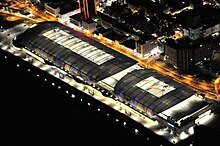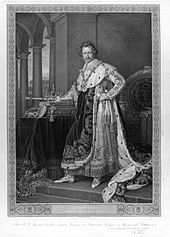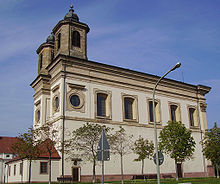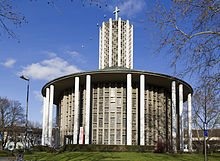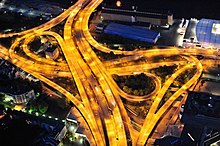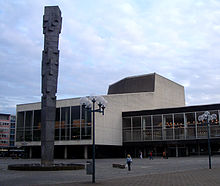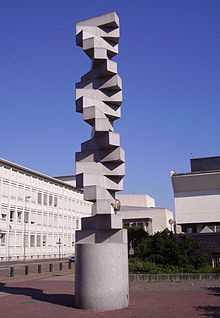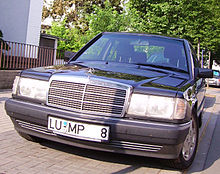Ludwigshafen am Rhein
| coat of arms | Germany map | |
|---|---|---|

|
Coordinates: 49 ° 29 ' N , 8 ° 27' E |
|
| Basic data | ||
| State : | Rhineland-Palatinate | |
| Height : | 95 m above sea level NHN | |
| Area : | 77.55 km 2 | |
| Residents: | 172,253 (Dec. 31, 2019) | |
| Population density : | 2221 inhabitants per km 2 | |
| Postcodes : | 67059-67071 | |
| Primaries : | 0621, 06237 | |
| License plate : | LU | |
| Community key : | 07 3 14 000 | |
| NUTS : | DEB34 | |
| City structure: | 10 districts | |
City administration address : |
Rathausplatz 20 67059 Ludwigshafen am Rhein |
|
| Website : | ||
| Lord Mayor : | Jutta Steinruck ( SPD ) | |
| Location of the city of Ludwigshafen am Rhein in Rhineland-Palatinate | ||

front left: port area
front right: parking island
behind: city center
right: Rhine right: Mannheim
Ludwigshafen am Rhein [ ˈlutvɪçsˌhafn̩ ʔam ʁaɪ̯n or ˈluːtvɪks- ] is the largest city in the Palatinate , with around 171,000 inhabitants (as of 2019) the second largest city in Rhineland-Palatinate after Mainz and the second largest city in the Rhine-Neckar metropolitan region after Mannheim .
Located on the left bank of the Rhine across from the Baden-Württemberg sister city of Mannheim, Ludwigshafen emerged from the former Mannheim Rheinschanze . In 1853 it officially became a separate municipality. The city is best known as the headquarters of BASF and the hometown of Helmut Kohl . Ludwigshafen and Mannheim form a coherent urban area and share, among other things, the tram network and the telephone network with the common area code 0621.
Ludwigshafen is an independent city and at the same time the administrative seat of the Rhine-Palatinate district surrounding the city . It is one of the five regional centers in the state of Rhineland-Palatinate.
Further major cities in the vicinity are Mainz (approx. 60 km north), Darmstadt (approx. 45 km northeast), Heidelberg (approx. 25 km southeast) and Karlsruhe (approx. 50 km south).
The city's population exceeded 100,000 in 1921, making it a major city in less than a century after it was founded.
geography
Geographical location
Ludwigshafen is located in the floodplains on the left bank of the Upper Rhine Graben , opposite the mouth of the Neckar into the Rhine . The city lies in the core of the Electoral Palatinate and is also one of its largest cities.
climate
Ludwigshafen has a very mild and dry climate . The annual average temperature is 11.2 ° C. In summer it is often oppressively humid due to the proximity to the Rhine, Neckar and the 17 ponds. In addition, stronger storms afflict the city at this time of the year, coming from the southwest to the west. The previous maximum temperature was reached during the heat wave of 2003 in August and was 40.1 ° C. The highest mean monthly temperature was measured in July 2006 at 25.18 ° C (long-term average at around 20 ° C). On August 11, 2006 a tornado or funnel was observed in the Rhein-Pfalz-Kreis near Maxdorf . On July 19, 2015, another funnel was discovered near Rheingönheim .
Neighboring communities
The following cities and municipalities border the city of Ludwigshafen (list clockwise , starting in the east):
Mannheim ( urban district in Baden-Württemberg), Altrip , Neuhofen , Limburgerhof , Mutterstadt as well as Fußgönheim and Maxdorf ( Verbandsgemeinde Maxdorf ) (all belonging to the Rhein-Pfalz district ) and Frankenthal (Pfalz) ( independent city ).
City structure
According to § 2 of the main statutes of the city of Ludwigshafen, the urban area of Ludwigshafen is divided into ten local districts .
In each local district there is a local council of 7 to 15 members and a local councilor . They are elected for five years. The local councils are to be heard on important matters affecting the local district. The final decision on a measure is then incumbent on the Ludwigshafen city council .
The local districts are partly subdivided into further city districts or statistical districts . This classification is only used for statistical purposes.
Districts
The districts have been since 1974: Mitte, Süd, Nord / Hemshof, West, Friesenheim, Oppau, Edigheim and Pfingstweide, Gartenstadt, Mundenheim, Oggersheim, Rheingönheim, Maudach and Ruchheim.
Districts
Local districts with their associated districts are:
| location | coat of arms | Example image | District | Breakdown | Local advisory board |
|---|---|---|---|---|---|

|

|

|
Friesenheim (mentioned in 771, incorporated in 1891) |
Friesenheim Froschlache |
15 members |

|

|

|
Garden City (founded in 1909) |
Hochfeld Niederfeld Ernst Reuter settlement |
15 members |

|

|

|
Maudach (mentioned in 770, incorporated in 1938) |
- | 7 members |

|

|

|
Mundenheim (mentioned in 770, incorporated in 1899) |
- | 11 members |

|

|

|
Northern downtown | North Hemshof West |
15 members |

|

|

|
Oppau (mentioned in 808, incorporated in 1938) |
Oppau Edigheim Pfingstweide |
15 members |

|

|

|
Oggersheim (mentioned in 769, incorporated in 1938) |
Oggersheim Melm emergency turnaround |
15 members |

|

|

|
Rheingönheim (mentioned in 831, incorporated in 1938) |
- | 7 members |

|

|

|
Ruchheim (mentioned around 800, incorporated in 1974) |
- | 7 members |

|

|

|
South downtown | Middle south |
15 members |
history

Early and ancient times
The Ludwigshafen area has been settled very early on. According to some historians existed in the area of the district Rheingönheim the Roman fort Rufiniana . The Roman Rhine Valley Road led from Speyer to Worms through the districts of Maudach and Oggersheim .
Rheinschanze
In 1607, Elector Friedrich IV of the Palatinate founded the Mannheimer Rheinschanze on the west bank of the Rhine as a bridgehead of the Mannheim Fortress . After the city of Mannheim was re-established in 1720, it was expanded and razed by French troops between 1799 and 1804 - during the French era .
19th century
In 1811 a private ship landing site on the Rhine was built at this point. After the Congress of Vienna , the Palatinate on the left of the Rhine became part of Bavaria in 1816 ; the Electoral Palatinate on the right of the Rhine with the former capital Mannheim remained with Baden , to which it had come in 1803. The area of the future city of Ludwigshafen initially belonged to the canton of Mutterstadt . In 1818 this canton became part of the Speyer Land Commissioner in the Rhine district , the forerunner of the Speyer district .
From 1820 a private trading post with an artificial harbor basin was established on the site, which was acquired by the Bavarian state on March 14, 1843, on the initiative of the Palatinate District President, Prince Eugen von Wrede . He renamed it Ludwigshafen in honor of King Ludwig I of Bavaria and supported the rapid expansion as an industrial counterpoint to the Baden city of Mannheim. Nine years later, the up-and-coming settlement was declared an independent municipality within the Speyer Land Commission , which was formally established with effect from April 14, 1853. Its municipal area was 366 ha , which it received as follows: 240 ha from the municipality of Friesenheim and 126 ha from the municipality of Mundenheim . Both places were later incorporated.
In 1852 King Maximilian II granted Ludwigshafen the rights of a community:
“His Majesty the King has graciously deigned to approve the formation of a separate political community in Ludwigshafen, consisting of the settlements in Ludwigshafen, the Hemshöfen, the Ganterhof and Rohrlachhofe, then the Graefenau, and also the ban department between the communities of Friesenheim, Mundenheim and Ludwigshafen . "
| Political affiliation of Ludwigshafen since 1853 | ||
| Country | Administrative unit | Affiliation |
| Bavaria | Palatinate | 1853-1871 |
| Germany | Kingdom of Bavaria | 1871-1918 |
| Germany | Free State of Bavaria | 1918-1933 |
| Germany | Bavaria | 1933-1945 |
| Germany | ||
| Bavaria | 1945-1946 | |
| Rhineland-Palatinate | 1946-1949 | |
| Germany | Rhineland-Palatinate | since 1949 |
On November 8, 1859, the community of Ludwigshafen was raised to the city . In 1860 she took over the district seat previously located in Mutterstadt, so that there was now a separate Ludwigshafen district in the Speyer Land Commissioner.
On May 8, 1865, the concession to locate the Badische Anilin- und Sodafabrik ( BASF ) was granted. This company had been founded shortly before, but had not been granted a site by the Mannheim municipal council, which is why the "Baden" company, according to his company, switched to the opposite bank of the Rhine in the Palatinate, which belongs to Bavaria . BASF later became a global chemical company that shapes the face and history of the city to this day. The abbreviation BASF is now the company's official name. In the local colloquial language she is still often called "the aniline", and her employees " aniline ".
In 1882 the city was given the addition of "am Rhein" to distinguish it from other places of the same name. In 1886, the former Speyer Land Commissioner, known as the District Office since 1862 , was divided. Ludwigshafen thus became the seat of its own district office, from which the Ludwigshafen am Rhein district emerged in 1939 .
Early 20th century
In 1920 Ludwigshafen became a district direct , that is, it left the district office of Ludwigshafen, but initially remained under the financial sovereignty of the district office. The mayor received the title of Lord Mayor. In 1925 Ludwigshafen became a major city.
In Oppau (incorporated in 1938), 561 people were killed and more than 2000 injured in the explosion of the BASF nitrogen plant on September 21, 1921 .
Second World War
During the Second World War , Ludwigshafen, together with Mannheim and its war industries, became one of the most bombed conurbations in southern Germany . Over 80% of the buildings in the inner city area are completely destroyed by the 124 air raids, some of which are devastating . Ludwigshafen and Mannheim were also possibly targets of the USA for an atomic bomb. Since the bomb was not completed until after the end of the war in Europe , on August 6, 1945, a nuclear weapon was first used in a war over Hiroshima .
During the Second World War, around 50,000 foreign workers and prisoners of war were used for forced labor in Ludwigshafen. Already exposed to harsh working and living conditions - this applies above all to the so-called Eastern workers - the forced laborers suffered particularly from the effects of the bombing.
End of the war by the turn of the millennium
After the end of World War II, Ludwigshafen was initially under the control of the American military government. From July 10, 1945, Ludwigshafen belonged to the French occupation zone and was - before Freiburg im Breisgau and the heavily destroyed Mainz - its most populous city. The establishment of the state of Rhineland-Palatinate was ordered on August 30, 1946 as the last state in the western occupation zones by decree No. 57 of the French military government under General Marie-Pierre Kœnig . It was initially referred to as the "Rhineland-Palatinate Land" or "Land Rheinpfalz"; the name Rhineland-Palatinate was only established with the constitution of May 18, 1947.
Due to the different policies of the occupying powers in occupied Germany, it took a relatively long time in Ludwigshafen - it was in a region disadvantaged by the occupiers - compared to other cities for reconstruction to get underway. The city was hastily rebuilt in a simple style, with the aim of addressing the acute housing shortage in the city center as well. Therefore, almost everywhere in the cityscape there is a lack of architecturally high-quality buildings, successful and well thought-out urban planning - as well as, contextually, many parts that are important for a functioning infrastructure.
On the afternoon of July 28, 1948 , a rail tank car with 30 tons of extremely flammable dimethyl ether exploded at BASF , helped by the summer heat . The death toll was 207 and nearly 4,000 people were injured. Serious damage to buildings occurred on the BASF site and in the vicinity.
In terms of traffic engineering, major projects were implemented in the 1960s. In addition to the relocation of the station and the abandonment of the railway systems between the north and center districts, the business card project implemented the construction of elevated roads based on the American model.
In the course of the Rhineland-Palatinate regional reform , the municipality of Ruchheim was incorporated in 1974. The urban area thus reached its present size.
21st century
In 1997, the city began with CONNECTION 2000 - after the business card project, the second major urban development challenge. The project included, among other things, the redesign of Berliner Platz and its connection to the Rhine, the construction of a second railway bridge and the Ludwigshafen-Mitte S-Bahn stop on Berliner Platz and the construction of the Walzmühle shopping center in the south of the city center. The project was realized in 2006/07.
On February 3, 2008, a serious house fire occurred in Ludwigshafen in which nine Alevis of Turkish descent were killed. Rumors of a possible arson as well as slow help from the fire brigade turned out to be unfounded; at times they burdened the German-Turkish relationship .
On May 25, 2009, the city received the title “ Place of Diversity ” awarded by the federal government .
The city center was brought back to the Rhine in 2010 through the construction of a new city quarter on the site of the former Zollhofhafen ( Rhein-Galerie Ludwigshafen shopping center , town square with extension and expansion of the existing Rhine promenade, gastronomy, event hall in the first construction phase). The investor in the 220 million euro project is the Hamburg-based ECE Projektmanagement , which also operates the shopping center. The redesign of the Zollhof is part of the urban redevelopment program “Today for Tomorrow”.
In June 2013, Ludwigshafen was hit by a flood of the Rhine, in which the city park on the Parkinsel, the Rhine promenade and the city square at the Rhein-Galerie were partially or completely flooded. The Rhine reached a high of 8.35 m. The city park on the park island was up to two meters under water.
On November 26th and December 5th, 2016 there were two attempted attacks on the Ludwigshafen Christmas market and on Rathausplatz . A 12-year-old boy, Iraqi and German citizenship, tried to carry out an attack using a nail bomb and another self-made explosive device. According to the police, there is a connection to the terrorist organization Islamic State , they are said to have instructed the boy to build the bombs via messenger services. The case attracted international attention, and never before has an alleged assassin been so young. Due to his age, however, he is not of legal age.
Incorporations
A number of formerly independent cities and communities have been incorporated into the city of Ludwigshafen am Rhein:
| date | Incorporated place | growth |
|---|---|---|
| January 1, 1892 | Community Friesenheim | 772 ha |
| December 1, 1899 | Community Mundenheim | 1027 ha |
| April 1, 1938 | City of Oppau (with Edigheim , which was incorporated on April 1, 1929 ) |
1677 ha |
| April 1, 1938 | City of Oggersheim | 1087 ha |
| April 1, 1938 | Maudach municipality | 787 ha |
| April 1, 1938 | community Rheingönheim | 1172 ha |
| March 16, 1974 | community Ruchheim | 961 ha |
When the community of Ludwigshafen was founded in 1853, the area covered only 366 hectares.
Population development
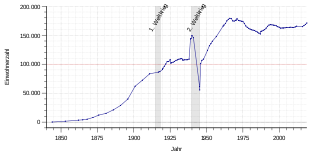
In 1888 Ludwigshafen had 25,000 inhabitants, by 1899 this number had doubled to more than 50,000. The city's population exceeded 100,000 in 1921, making it a major city . In 1965 the population reached its historic high of around 180,000. On December 31, 2006, the “ official population ” for Ludwigshafen was 163,560 according to an update by the State Statistical Office of Rhineland-Palatinate (only main residences and after comparison with the other state offices). The proportion of foreigners was 21.1%.
As of December 31, 2019, Ludwigshafen was ranked 45th in the list of major cities in Germany in terms of population ; Neighboring spaces occupy z. B. Potsdam , Hamm , Oldenburg and Osnabrück .
Religions
Denomination statistics
According to the 2011 census , in 2011 26.5% of the population were Protestant , 28.5% Roman Catholic and 45.0% were non-denominational , belonged to another religious community or did not provide any information.
As of December 31, 2016, of the 171,172 inhabitants, 37,507 (21.9%) were Protestant, 45,081 (26.3%) Roman Catholic and 51.7% belonged to other denominations or religious communities or were non-denominational.
Currently (as of January 31, 2020), 34,019 (19.4%) of the population are Protestant, 42,640 (24.3%) Roman Catholic and 56.3% are non-denominational or belong to another religious community.
history
The area of the city of Ludwigshafen belonged to the Electoral Palatinate and was thus a predominantly Protestant area. However, shortly after the congregation was founded, Roman Catholic residents moved in, so that both denominations were represented in a relatively balanced way.
The Protestant residents initially belonged to the parishes of Oggersheim and Frankenthal (Palatinate) before they received their first independent parish in 1862. In 1913 the Protestant Dean's Office in Ludwigshafen was founded within the Evangelical Church of the Palatinate (Protestant State Church) , to which all Protestant parishes in the city belong, unless they are members of a free church. There has been a Mennonite community since 1702 , initially in Friesenheim. After the Second World War, the previous Mennonite church was demolished in the course of road construction work and the current building in the city center was made available. The community rooms are located behind a residential building.
The Roman Catholic residents initially belonged to the parishes of Friesenheim, Mundenheim and Oppau, before they received their first independent parish in 1857. Around 1913 the Catholic city dean of Ludwigshafen was established within the Diocese of Speyer , to which all Catholic parishes in the city belong.
In 1891 Joseph Queva, after whom a place in Oggersheim was named because of his work in trade unions and politics, founded a free religious community in Ludwigshafen. In 1926 the community received corporate rights. It was banned by the National Socialist regime on April 5, 1933. In 1946 it was able to be re-established. Since 1952 it has had a party room and its office in the Johannes-Ronge-Haus. The Free Religious State Community of Palatinate , Kdö.R., has its seat there.
An independent Jewish community existed until the " Wagner-Bürckel-Aktion " in 1940. The regional association of the Jewish communities of Rhineland-Palatinate operates a community center in Ludwigshafen.
Since the Second World War, immigrants have also added other religions - above all Islam . There are twelve mosques in Ludwigshafen (as of January 2018).
politics
City leaders and city council

Since the founding of the municipality in 1853, the head of the municipality (or city) of Ludwigshafen has been an honorary, from 1896 a full-time mayor , who received the title of Lord Mayor from 1920.
The city council is made up of the mayor and the four department heads - a mayor and three councilors. This is where the administration's internal decision-making takes place. The department heads are elected by the city council for a term of eight years.
Community and city leaders
- 1853–1862: Heinrich Wilhelm Lichtenberger
- 1863–1868: Carl Huss
- 1868–1872: Joseph Hoffmann
- 1872–1889: Georg Kutterer
- 1890–1891: Wendelin Hoffmann jun.
- 1891–1896: Carl Grünzweig
- 1896–1920: Friedrich Krafft
- 1920–1930: Christian Weiß
- 1931–1937: Fritz Ecarius
- 1937–1941: Erich Stolleis ( NSDAP )
- 1941–1942: Franz Schubert , acting
- 1942–1943: Ludwig Holzer, acting
- 1943–1945: Hans Horn, acting
- 1945 : Otto Stabel , acting
- 1945 : Hans Hoffmann ( SPD )
- 1945–1955: Valentin Bauer (SPD)
- 1955–1957: Werner Bockelmann (SPD)
- 1957–1965: Hans Klüber (SPD)
- 1965–1993: Werner Ludwig (SPD)
- 1993-2001: Wolfgang Schulte (SPD)
- 2001–2017: Eva Lohse ( CDU )
- 2018– : Jutta Steinruck (SPD)
City council
(-8.5)
(-8.7)
(+7.7)
(+5.5)
(+2.0)
(+1.6)
(+0.5)
(+0.7)
( n.k. )
The city council of Ludwigshafen am Rhein consists of 60 honorary council members, who were elected in a personalized proportional representation in the local elections on May 26, 2019 , and the full-time mayor as chairman.
Because of the special features of the Rhineland-Palatinate electoral system in local elections (personalized proportional representation), the percentages given are shown as weighted results that only represent the voting behavior in arithmetic.
The parties and voter groups achieved the following results:
| Parties and groups of voters | % 2019 |
Seats 2019 |
% 2014 |
Seats 2014 |
|---|---|---|---|---|
| SPD | 26.0 | 16 | 34.5 | 21st |
| CDU | 24.3 | 15th | 33.0 | 20th |
| B90 / greens | 16.6 | 10 | 8.9 | 5 |
| AfD | 13.5 | 8th | 8.0 | 5 |
| FDP | 5.7 | 3 | 3.7 | 2 |
| FWG | 5.7 | 3 | 4.1 | 2 |
| left | 4.5 | 3 | 4.0 | 2 |
| Pirates | 1.5 | 1 | 0.8 | 1 |
| BIG | 1.2 | 1 | - | - |
| LKR | 0.6 | 0 | - | - |
| List Dr. Cont | 0.4 | 0 | - | - |
| Others | - | - | 3.0 | 2 |
| total | 100.0 | 60 | 100.0 | 60 |
| Voter turnout in% | 46.4 | 40.7 | ||
- BIG = Alliance for Innovation and Justice
coat of arms
The coat of arms of the city of Ludwigshafen shows a lowered golden anchor in red. The city colors are red-yellow-red.
The anchor as a symbol of shipping should symbolize the city at the Rhine harbor . Today's coat of arms was approved by the Reich governor in Bavaria on September 14, 1937. The anchor was also shown in the city's first coat of arms from 1853. With the incorporation of neighboring towns, the coat of arms also changed, namely in 1895 and then again in 1900. The coats of arms of that time showed a four-part shield with anchors, diamonds and spades or anchors, diamonds, spades and keys. In 1937 the coat of arms was reduced to the anchor alone. The city colors, which are usually derived from the coat of arms colors, were not officially approved until 1895.
Town twinning
- Pasadena (United States), since 1948
- Lorient (France), since 1963
- London Borough of Havering (United Kingdom), since 1971
- Sumqayıt (Azerbaijan), since 1987
- Dessau-Roßlau (until June 30, 2007 Dessau ) (Germany), since 1988
- Antwerp (Belgium), since 1999
- Gaziantep (Turkey), since 2012
Economy and Infrastructure
In 2016, Ludwigshafen achieved a gross domestic product (GDP) of € 13.546 billion within the city limits, making it 26th in the ranking of German cities by economic output and first in Rhineland-Palatinate. In the same year, GDP per capita was € 81,765 (Rhineland-Palatinate: € 34,118, Germany € 38,180), making it the ninth-highest among all urban districts in Germany. The GDP per labor force is € 107,198, which makes Ludwigshafen the city with the third highest employee productivity. In 2016, around 126,400 people were employed in the city. However, the unemployment rate in January 2020 was 8.9% and thus well above the Rhineland-Palatinate average of 4.7%.
Ludwigshafen is the major city in Germany that has the highest proportion of inbound commuters with 68.7% of all employees.
In the Future Atlas 2016 , the city of Ludwigshafen was ranked 187 out of 402 districts, municipal associations and cities in Germany, making it one of the places with a “balanced risk-opportunity mix” for the future.
Chemical industry

The headquarters of BASF is located in Ludwigshafen and operates the largest connected chemical site in the world here - divided into more than 300 individual companies. Other chemical companies such as DyStar GmbH & Co. KG, Woellner GmbH & Co. KG and Raschig GmbH have settled in the vicinity of BASF and through spin-offs . The Abbott GmbH arose from the Knoll AG, BASF earlier pharmaceutical division.
Established businesses
- AbbVie
- BASF SE
- BASF IT Services
- Baker Görtz GmbH
- DHL Logistics GmbH
- DyStar GmbH & Co Germany KG
- GAG Ludwigshafen
- Joseph Vögele AG
- Media Union (Rheinpfalz)
- medpex mail order pharmacy
- Pfalzwerke AG
- Planex Technik in Textil GmbH
- Private brewery Gebr. Mayer
- Radio RPR GmbH & Co. KG
- Raschig GmbH
- Saint Gobain G + H Isover AG
- Shell Germany Oil GmbH
- Sparkasse Vorderpfalz Ludwigshafen a. Rh.-Schifferstadt
- Technical Works Ludwigshafen AG
- Triport GmbH
traffic
Road traffic
The Federal Motorway 6 Saarbrücken-Nuremberg runs through the northern part of the city . In the west of the city, the federal motorway 61 Speyer-Koblenz passes. The A 65 (replacement for the B 38 ) in the direction of Neustadt an der Weinstrasse and the A 650 in the direction of Bad Dürkheim also begin here . The following federal highways run through the city: from south to north the B 9 , to the west the B 37 to Bad Dürkheim and to the south the B 44 .
railroad
The unusually built main station (combination of wedge and tower station ), inaugurated in 1969 as the “most modern station in Europe” and located west of the city center, has not been the most frequented station in the city since December 2003; it is now the much more centrally located Ludwigshafen station (Rhine ) Middle . Both stations are connected to regional traffic and the RheinNeckar S-Bahn . Since there is only a sporadic connection to long-distance traffic in Ludwigshafen itself, both stations are overshadowed by the supraregional long-distance hub Mannheim Hauptbahnhof , which is less than a kilometer away from Ludwigshafen's banks of the Rhine and represents the most important access to rail transport for the entire city region and thus also for Ludwigshafen.
There are district train stations in Oggersheim , Mundenheim and Rheingönheim and three works train stations (BASF-Süd, BASF-Mitte, BASF-Nord) on the BASF site .
Since December 14, 2003, the RheinNeckar S-Bahn has been opening up the entire Rhine-Neckar area with lines that lead to the West Palatinate, the Odenwald and southern Hesse.
Public transport
Local public transport in Ludwigshafen is supplied by several tram and bus routes operated by the RNV . All public transport can be used at uniform prices within the Rhein-Neckar transport association (VRN).
In the 1970s, plans were made to build the Mannheim-Ludwigshafen underground network, but this was never completed for cost reasons. Most of the subway stations built by then are served by normal trams. The platform height is 35 cm, 80–90 cm high platforms and 80 m long underground stations were planned. Underground and elevated train stations are: Hauptbahnhof, Rathaus-Center B-level, Hemshofstraße and Gartenstraße. The underground stations Rathaus-Center C-level, Danziger Platz and the east exit of the main station were closed with the discontinuation of tram line 12 in December 2008. In the end they were only served during the working day rush hour.
Waterway
With the Rhine port, the city has the largest and most powerful port in Rhineland-Palatinate. With a cargo handling of 7.1 million tons in 2005, it is one of the most important inland ports in the Federal Republic.
air traffic
There is no direct international airport in or around Ludwigshafen. The closest major international airport is Frankfurt am Main Airport , which is 65 kilometers away by motorway or rail transport. Closer airfields include the Mannheim airfield on the other side of the Rhine or the Speyer airfield south of Ludwigshafen .
Events
The Ludwigshafen Congress and Marketing Society mbH (Lukom) is responsible for events in the city of Ludwigshafen, often in cooperation with the Ludwigshafen Marketing Association. V.
The marketing association was founded on July 15th, 1998 as a consistent continuation of an integrated city marketing process. It is an association of representatives from numerous institutions and interested citizens of the city of Ludwigshafen. The marketing association now has 161 members, 69 of whom are individuals, 92 companies and associations. The composition of the board and the members shows the broad acceptance and support by the institutions. The chairman of the association is Lord Mayor Jutta Steinruck, Michael Cordier is the managing director.
Regular events
- January: Ergo-Cup Rhein-Neckar (largest indoor rowing competition in southern Germany organized by the Ludwigshafen rowing club )
- February: Carnival parade (annually alternating with Mannheim )
- February: Altweiberfasnacht ( Eberthalle )
- May: Hanami (Pfalzbau Ludwigshafen)
- June: Park Festival ( Ebertpark )
- June: Election for Miss Ludwigshafen ( Ebertpark )
- June / July: Ludwigshafen city festival (city center)
- June / July: Summer night concerts by the Carl-Bosch-Gymnasium (Pfalzbau)
- July / August: Rhineland-Palatinate cultural summer ( street theater )
- August: LUftsprung Children's Festival - A city plays (city center)
- August / September: Festival of German Film Ludwigshafen am Rhein
- September: Springboard LU ( Friedrich-Ebert-Halle )
- October: Friesenheimer Kerwe
- November: Street Carnival (light gate at the town hall center)
- November / December: Christmas market (Berliner Platz)
- November / December: Winterdorf (Place of German Unity)
- November / December: Ludwigshafen magic lights (city center)
- Summer / Autumn: "Clean City" campaign
- April - September: Skatenight Ludwigshafen (Start: Wednesday 7.30 p.m. Berliner Platz, every 14 days)
Regular district festivals, district kerwe
Time sequence in the calendar year:
- Pentecostal willow
- Hemshof
- Oggersheim emergency turnaround
- Mundenheim; Oppau
- Oggersheim; Edigheim
- Ruchheim
- Friesenheimer Eulekerwe
- Maudach
- Rheingönheim
media
Ludwigshafen is the seat of Radio RPR , the oldest private radio broadcaster in southwest Germany, and the Landeszentrale für Medien und Kommunikation Rheinland (LMK) Pfalz. In addition, the youth broadcaster BigFM and the Open Channel ran a studio here.
The Südwestfunk and later the Südwestrundfunk operated the Ludwigshafen studio in the city. The SWR-Studio Ludwigshafen still exists, but it is now on the other side of the Rhine in Mannheim , in a studio community with the SWR-Studio Mannheim.
Since 1989, the episodes of the ARD crime series Tatort have been playing in Ludwigshafen with the inspector Lena Odenthal played by Ulrike Folkerts . They were initially produced for Südwestfunk and today for Südwestrundfunk.
The only daily newspaper to appear is the main edition of the Rheinpfalz , a regional newspaper with numerous local editions throughout the Palatinate with a total circulation of 250,000 copies. In addition, the Ludwigshafener Wochenblatt is published every Wednesday .
In Ludwigshafen, private television and thus the dual broadcasting system in Germany began on January 1, 1984 with the Ludwigshafen cable pilot project . The station PKS started broadcasting from a basement studio, which one year later became Sat.1 . The Rhein-Neckar Fernsehen radiates Mannheim from regional issues.
The 138 m high telecommunications tower Ludwigshafen am Rhein is a transmitter for VHF radio.
education
- Heinrich-Pesch-Haus , a Catholic Academy Rhein-Neckar, sees itself as a competence center for applied ethics .
University
On March 1, 2008, the two Ludwigshafen universities of applied sciences (Protestant University and University of Economics) were merged to form Ludwigshafen am Rhein University . It is an institution of the federal state of Rhineland-Palatinate and offers courses in four subject areas. The East Asia Institute at Ludwigshafen University offers a combination of business administration and Chinese, Japanese or Korean languages.
The nearest university is the University of Mannheim , with which there is a close cooperation and whose facilities can be used by students of the Ludwigshafen University of Applied Sciences .
Elementary schools
- Albert Schweitzer School
- Alfred Delp School
- Astrid Lindgren School
- Bliesschule
- Brothers Grimm School
- Erich Kästner School
- Ernst Reuter School
- Goethe-Mozart School
- Goetheschule North
- Grafenau School
- College
- Karl Kreuter School
- Primary school in the Langgewann (Langgewannschule)
- Lessing School
- Luitpold School
- Lukas School
- Mozart School Rheingönheim
- Niederfeldschule
- Pentecostal willow
- Rupprecht School
- Schiller School Mundenheim
- Schiller School Oggersheim
- Wittelsbach School
- Wilhelm-Leuschner-Schule (organizationally linked to Realschule plus)
High schools
- Carl-Bosch-Gymnasium
- Geschwister-Scholl-Gymnasium
- Heinrich Böll High School
- Max Planck High School
- Theodor-Heuss-Gymnasium
- Wilhelm von Humboldt Grammar School
Integrated comprehensive schools
- Integrated comprehensive school Ernst Bloch Oggersheim
- Integrated comprehensive school in Gartenstadt
- Integrated comprehensive school Edigheim
Realschulen plus
- Anne Frank Realschule
- Karolina Burger Secondary School
- Adolf Diesterweg School
- Ernst Reuter School
- Realschule plus at Ebertpark
Special schools
- Schillerschule Mundenheim, school with a special focus on learning
- Schloss-Schule Oggersheim, school with a special focus on learning
- School an der Blies, school with a special focus on learning
- Georgensschule, school with a focus on holistic development
- School with a focus on motor development (not sponsored by the city of Ludwigshafen)
Vocational schools
- BBS Economy 1 (with Business High School)
- BBS Economy 2
- BBS Social Services, Health and Housekeeping
- BBS technology 1
- BBS technology 2
- BBS natural sciences
- Private business school Dr. H. Stracke (PHS)
Workshops for people with disabilities
- Ludwigshafen workshops in the joint venture for people with disabilities
- Maudacher workshop
Other public institutions
- In Ludwigshafen, the state of Rhineland-Palatinate maintains a socio-therapeutic prison, the Ludwigshafen prison, which treats sex offenders in particular.
Culture and sights
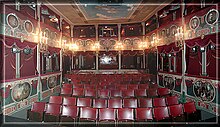
Theater and orchestra
- Theater im Pfalzbau (without its own ensemble)
- Mobile children's and youth theater KiT'Z
- Studio stage TiP
- Prinzregenten Theater in the Hemshof
- Theater Hemshof box
- Office for applied realism , performance group since 1984
- State Philharmonic of Rhineland-Palatinate - The orchestra was founded in Landau in 1919 and is based in Ludwigshafen. It has participated in world premieres of works by Werner Egk , Giselher Klebe and Wolfgang Rihm . Karl-Heinz Steffens has been the chief conductor since August 1, 2009 .
Libraries
Museums
- Mayor Ludwig Reichert House (Art Association)
- Ernst Bloch Center Exhibition on Ernst Bloch (Bloch Archive) and temporary exhibitions
- Local history museum in Friesenheim (cultural history)
- Karl Otto Braun Museum in Oppau (cultural history)
- Schiller House in Oggersheim (Friedrich Schiller first prints)
- City Museum Ludwigshafen (City History)
- Wilhelm Hack Museum (Gondorfer Fund, Middle Ages, Classical Modernism and Graphic Cabinet)
- Katzinett in Friesenheim (cat museum )
The annual " Long Night of the Museums " (together with Mannheim and Heidelberg) is the second largest event of its kind in Germany after Berlin .
Buildings
- Pilgrimage church Mariae Himmelfahrt in Oggersheim (1774/93), the most important architectural monument in the city area
- Tower of the Luther Church (formerly the city's oldest Protestant church, 1858/64, tower from 1878/80)
- Catholic Church St. Ludwig (1858/62, tower from 1883)
- Apostle Church (1892/94)
- Friedenskirche (1931/32)
- Friedrich-Ebert-Halle (1965)
- Südweststadion (1937/40, reconstruction 1946/50), formerly the venue for the Bundesliga soccer games of SV Waldhof Mannheim and the regional league games of FSV Oggersheim
- BASF high-rise " Friedrich-Engelhorn-Hochhaus " (1954/57), demolished in 2013/14
- Department store on Berliner Platz ( cake box , round building with integrated tram stop), demolished in 2015
- Elevated roads and pylon bridge (1959/72), partial demolition planned
- Ludwigshafen (Rhein) Hauptbahnhof , once the most modern in Europe, with traffic on four floors (1969)
- City Hall ( landmark of the city, opened 1979)
- Wilhelm Hack Museum with extensive facade cladding by Joan Miró (inaugurated in 1979)
- Telecommunication tower in reinforced concrete construction, height: 138 meters (geographic coordinates: 8 ° 25'25 "east longitude, 49 ° 28'28" north latitude)
- East Asia Institute on the South Bank of the Rhine (1997)
- Factor house on Berliner Platz (a semicircular office and commercial building, 2004/2005)
- Rolleswasserturm in the Nord district, Hemshof, octagonal former air raid shelter with a water tower structure, 53 meters high.
- Rhein-Galerie : shopping center built on the site of the former Zollhofhafen, which opened in September 2010 and is operated by ECE .
Art in public space
- Stylized city arms on the Rhine port by Eugen Roth , 1953
- Ice skater by Giacomo Manzù , 1957
- Palatine column by Blasius Spreng and Ernst W. Kunz , 1968
- Room column 22/1968 by Erich Hauser , 1968
- Miró wall at the Wilhelm Hack Museum , 1979
- Spatial structure sculpture in front of the council chamber of the town hall center by Eugen Roth. 1979
- District fountain , built by 15 journeyman stone masons under the direction of Hans-Günther Thiele , 1985
- Endless Staircase (Monument to Ernst Bloch ) by Max Bill , 1991
- Luther Fountain by Gernot and Barbara Rumpf , 1992
- Split sphere by Friedrich Becker , 1992
- Deux lignes indéterminées ( Two indefinite lines ) by Bernar Venet , 1993
- Ring des Seyns by Kazuo Katase at the Ludwigshafen Clinic , 1998
- Stainless steel room sculpture with a blue mobile by Eugen Roth in Maudach Assisted Living , 1998
- Conversation by George Rickey , 1999
- Harlequin in front of Gerd Dehof's former youth house , 1967
- The fallen Prometheus at Michael Croissant's Carl-Bosch-Gymnasium
- Memorial for the Rheingönheim prisoner of war camp by Hans-Günther Thiele, 1991
- Rose fountain in the garden city by Hans-Günther Thiele, 1989
- Schiller monument in front of the Oggersheim town hall by Theo Siegle , 1955
- Franziskusbrunnen in front of the Friesenheimer Josefskirche by Max Faller , 1992
- Archer in front of the tower restaurant in Ebertpark by Ernst Moritz Geyger , 1928
- The big tiger in front of the municipal hospital of Maria Ewel , 1957
- Changing trade on Bismarck-Strasse by Maritta Kaltenborn
Other sights
Sports
Ludwigshafen is home to the handball club TSG Friesenheim , which has been playing in the 1st handball league again since the 2017/18 season and competes there under the name Die Eulen Ludwigshafen . The venue for the home games is the Friedrich-Ebert-Halle .
In football, Arminia Ludwigshafen's team in the Rhineland-Palatinate / Saar major league is the top-class team in Ludwigshafen. The FSV Oggersheim , another football club in the city, made the leap into the then third-class Regionalliga Süd in the 2006/2007 season . The 2007/2008 season, however, ended the team bottom of the table and rose through the reform of the league system in the three-tier and fourth-class regional league. The sporting rise of the club at that time was very much linked to the financial commitment of the multimillionaire Emmanouil Lapidakis . In addition, there are other football clubs in the city, with Ludwigshafener SC , Südwest Ludwigshafen and BSC Oppau being the best known and currently playing in the association league and district league.
Sports life in Ludwigshafen is known nationwide for the three “Rs”. This refers to the disciplines of rowing , wrestling and cycling , in which the athletes from Ludwigshafen and the Palatinate were successful in the past and still are today.
The center of rowing is the Ludwigshafen rowing club with its boathouse in the south district directly on the Rhine and near Ludwigshafen Park Island . Already at the Olympic Games in Paris in 1900 , the club's controlled four-man won the bronze medal. Twelve years later at the Olympic Games in Stockholm , the so-called Fickeisen foursome with the rowers Otto Fickeisen , Hermann Wilker , Rudolf Fickeisen , Albert Arnheiter and helmsman Otto Maier won one of the first Olympic gold medals for the German Rowing Association. Ludwigshafen rowers also won Olympic gold medals at the 1936 Summer Olympics in Berlin , by Paul Söllner and in 1972 in Munich by Alois Bierl . In addition, there have been other Olympic competitions, numerous victories at world championships and countless national and international titles.
In wrestling, the brothers Claudio , Pasquale and Thomas Passarelli , who all learned to wrestle in Ludwigshafen, are known beyond the city limits. In particular, Pasquale Passarelli's Olympic victory at the 1984 Olympic Games in Los Angeles went down in German sports history as The Golden Bridge . Wilfried Dietrich , who was known as the crane of Schifferstadt , lived in Ludwigshafen, fought successfully for the VfK Schifferstadt for a long time and won a total of five medals at the Olympic Games, including the gold medal in the freestyle of the heavyweights at the 1960 Games in Rome .
In cycling, the RC 1899 Ludwigshafen-Friesenheim is known for its successful athletes and its 333 meter long open cycle race track in the Friesenheim district. The track, inaugurated in 1956, is still the venue for track cycling races for young people.
The city is also home to the Postsportverein Ludwigshafen , which is part of the 2nd Bundesliga of the Deutsche Classic-Kegler Union e. V. plays.
The ERC Ludwigshafen has offered the opportunity to play ice hockey in the Mundenheim district for over 40 years. Outside of training and playing times, the ice rink is available for public runs, day care centers and schools.
Sports facilities
- Friedrich-Ebert-Halle , home venue of the handball Bundesliga club TSG Friesenheim with a capacity of 2500 spectators
- Athletics hall, Olympic base and competition site on a total of 4,890 square meters
- Südwestplatz, home ground of the soccer club Südwest Ludwigshafen with a capacity of 12,000 spectators
- Südweststadion , with a current capacity of 6,100 spectators, the stadium, which was reopened in 1952, is partly the venue for football matches and music events
- Ice rink in Saarlandstrasse, home of ERC Ludwigshafen
District sports facilities
Ludwigshafen has six district sports facilities. a. for ball sports and athletics and which are used jointly by the clubs and school sports in the districts of Edigheim, Gartenstadt, Mundenheim, Oggersheim, Rheingönheim and West.
Others
The nickname that the city of Ludwigshafen received in the 19th century from the residents of the area, especially those of the neighboring city of Mannheim, is Lumpenhafen , in the Palatinate Lumpehafe . " Lump " alluded to the working population of the young industrial location, which was seen as more proletarian than, for example, the bourgeoisie of Mannheim. "Lumpenhafen" is still occasionally used in Internet forums to denote the place of residence in Ludwigshafen disparagingly. For the unattractiveness of a transfer of Bavarian officials to the city, but also to the Palatinate in general, the saying "Who God wants to punish / he sends to Ludwigshafen ..." was created.
In order to counteract its reputation as an “unattractive industrial city”, the city beautification program “Today for Tomorrow” was launched, within the framework of which the large, modern shopping center “ Rhein-Galerie ” was created. Many streets were optically redesigned.
Personalities
See also
literature
- Kathrin Bräuer: Ludwigshafen. A picture book in color . Photos by Johannes Hahn. Wartberg, Gudensberg-Gleichen 2000 ISBN 3-86134-593-5
- Siegfried Fauck: History of the city of Ludwigshafen am Rhein in data . 2. A. Stadtarchiv, Ludwigshafen 1989 ISBN 3-924667-14-4
- City bibliography Ludwigshafen am Rhein. Volume 1 = appearances up to 1990 . By Jürgen Nürnberger, Ludwigshafen 1993 ISBN 3-929153-03-3
- City bibliography Ludwigshafen am Rhein. Volume 2 = publications 1991–1995 and supplements . By Jürgen Nürnberger, Ludwigshafen 1998 ISBN 3-929153-06-8
- City bibliography Ludwigshafen am Rhein. Volume 3 = publications 1996–2000 and supplements . By Jürgen Nürnberger, Ludwigshafen 2004 ISBN 3-929153-09-2
- City bibliography Ludwigshafen am Rhein. Volume 4 = publications 2001-2005 and supplements . By Jürgen Nürnberger, Ludwigshafen 2009 ISBN 978-3-929153-10-1 [previously 11715 references]
- City bibliography Ludwigshafen am Rhein. Volume 5 = publications 2006-2010 and supplements . By Jürgen Nürnberger, Ludwigshafen [in preparation 2011, appears periodically every 5 years]
- City book of Rhineland-Palatinate and Saarland. Volume IV 3 . Partial volume from the German city book. Urban History Handbook . Stuttgart 1964
- Eginhard Scharf: You did what you wanted with us. Foreign forced laborers in Ludwigshafen am Rhein 1939–1945. Publications of the Stadtarchiv Ludwigshafen am Rhein, Volume 33. Ubstadt-Weiher, Verlag Regionalkultur, 2004. ISBN 978-3-89735-293-3 p. With 88 illustrations and 39 tabs.
- Stefan Mörz u. a .: History of the city of Ludwigshafen am Rhein . 2 volumes and register volume. Verlag Stadt Ludwigshafen Stadtarchiv, 2003. ISBN 978-3-924667-35-1 .
Web links
- Official website of the city of Ludwigshafen am Rhein
- Official website for urban redevelopment
- Ludwigshafen in brief
- Literature from and about Ludwigshafen am Rhein in the catalog of the German National Library
- Literature about Ludwigshafen am Rhein in the Rhineland-Palatinate State Bibliography
- Link catalog on Ludwigshafen at curlie.org (formerly DMOZ )
Individual evidence
- ↑ a b State Statistical Office of Rhineland-Palatinate - population status 2019, districts, municipalities, association communities ( help on this ).
- ↑ 100 years of city statistics in Ludwigshafen am Rhein, information on urban development in Ludwigshafen am Rhein No. 03/2014, pp. 96–101.
- ^ Wilhelm Volkert (ed.): Handbook of Bavarian offices, communities and courts 1799–1980 . CH Beck, Munich 1983, ISBN 3-406-09669-7 , p. 43, 515, 572 .
- ↑ Palatinate-Rhenish family history , Volume 3, 1960, page 226; Excerpt from the source
- ↑ a b Wilhelm Volkert (Ed.): Handbook of the Bavarian offices, communities and courts 1799–1980 . CH Beck, Munich 1983, ISBN 3-406-09669-7 , p. 572 .
- ^ Wilhelm Volkert, Richard Bauer: Handbook of the Bavarian offices, municipalities and courts: 1799-1980 . Beck, Munich 1983, page 515
- ↑ Ludwigshafen threatened the atomic bomb. Die Rheinpfalz , August 5, 2015, accessed on September 4, 2016 .
- ↑ Ulrike Minor: Ludwigshafen 1956 - end of the war and a new democratic beginning . Ed .: Lothar Meinzer, Peter Ruf. Ludwigshafen am Rhein 1995.
- ^ Official Journal of the French High Command in Germany, No. 35 (1946), p. 292
- ^ Full text of the constitution of May 18, 1947
- ↑ Attempts by a twelve-year-old in Ludwigshafen. In: tagesschau.de. ARD, accessed on December 17, 2016 .
- ↑ a b c d e f Wilhelm Volkert (Ed.): Handbook of the Bavarian offices, municipalities and courts 1799–1980 . CH Beck, Munich 1983, ISBN 3-406-09669-7 , p. 515 .
- ^ Wilhelm Volkert (ed.): Handbook of Bavarian offices, communities and courts 1799–1980 . CH Beck, Munich 1983, ISBN 3-406-09669-7 , p. 463 .
- ↑ Official municipality directory (= State Statistical Office of Rhineland-Palatinate [Hrsg.]: Statistical volumes . Volume 407 ). Bad Ems February 2016, p. 170 (PDF; 2.8 MB).
- ^ City of Ludwigshafen am Rhein Religion , 2011 census
- ↑ Ludwigshafen am Rhein Statistical Yearbook 2017 page 36 Retrieved on July 18, 2019.
- ↑ Ludwigshafen am Rhein municipal statistics , accessed on March 5, 2020
- ^ Jewish community of the Rhine Palatinate, community center Ludwigshafen .
- ^ Mosques in Ludwigshafen
- ↑ Information about the city council on the website of the city of Ludwigshafen
- ↑ Explanation by the Land Returning Officer on weighted results.
- ^ Result of the election at the regional returning officer Rhineland-Palatinate
- ^ Website of the city of Ludwigshafen , accessed on March 1, 2014
- ↑ Current results - VGR dL. Retrieved January 7, 2019 .
- ^ Federal State of Rhineland-Palatinate. Federal Employment Agency, accessed on January 30, 2020 .
- ↑ FOCUS Online: In Ludwigshafen, most commuters work / high number also in some state capitals . In: FOCUS Online . ( focus.de [accessed on March 11, 2018]).
- ↑ Future Atlas 2016. (No longer available online.) Archived from the original on October 2, 2017 ; accessed on March 23, 2018 .
- ↑ Archived copy ( Memento from January 21, 2016 in the Internet Archive )
- ^ BASF Business Services GmbH . In: BASF . ( basf.com [accessed March 11, 2018]).
- ^ Anton Author: Ludwigshafen, DHL logistics center | Dietz AG. Retrieved March 11, 2018 .
- ↑ DyStar® Nanjing Colors successfully started trial production on 2nd Indigo line - DyStar . In: DyStar . April 11, 2013 ( dystar.com [accessed March 11, 2018]).
- ↑ Imprint and legal information - JOSEPH VÖGELE AG. Retrieved November 7, 2018 .
- ↑ Medien Union newspaper publishers & magazine publishers from Ludwigshafen am Rhein in the company database wirdzu-wem.de. Retrieved November 7, 2018 .
- ↑ medpex pharmacy: Imprint - medpex help. Retrieved on November 7, 2018 (German).
- ↑ Imprint | Pfalzwerke . In: pfalzwerke.de . ( pfalzwerke.de [accessed on November 7, 2018]).
- ↑ Imprint - Planex GmbH . In: Planex GmbH . ( planex-gmbh.de [accessed November 7, 2018]).
- ↑ Mayer's Brauwerk: News - Mayer's Brauwerk. Retrieved November 7, 2018 .
- ↑ Imprint . In: RPR1. September 7, 2016 ( rpr1.de [accessed November 7, 2018]).
- ↑ Raschig GmbH - Imprint. Retrieved November 7, 2018 .
- ↑ Imprint. Retrieved November 7, 2018 .
- ↑ LUDWIGSHAFEN, VALENTIN-BAUER-STR. 4. Retrieved November 7, 2018 (UK English).
- ↑ CONTARGO - Terminal Ludwigshafen. Retrieved November 7, 2018 .
- ↑ Maudacher workshop
- ↑ Where the Palatinate shines golden. (No longer available online.) Pfalz.de, archived from the original on July 14, 2014 ; Retrieved June 8, 2014 .
- ^ Representation of the Landtag Rhineland-Palatinate; second last paragraph



